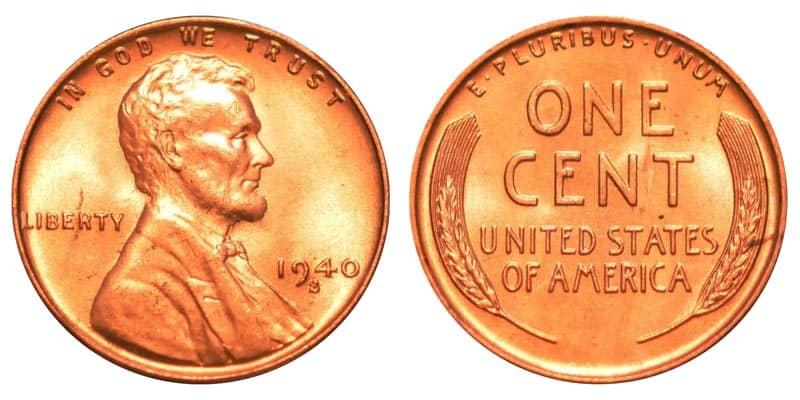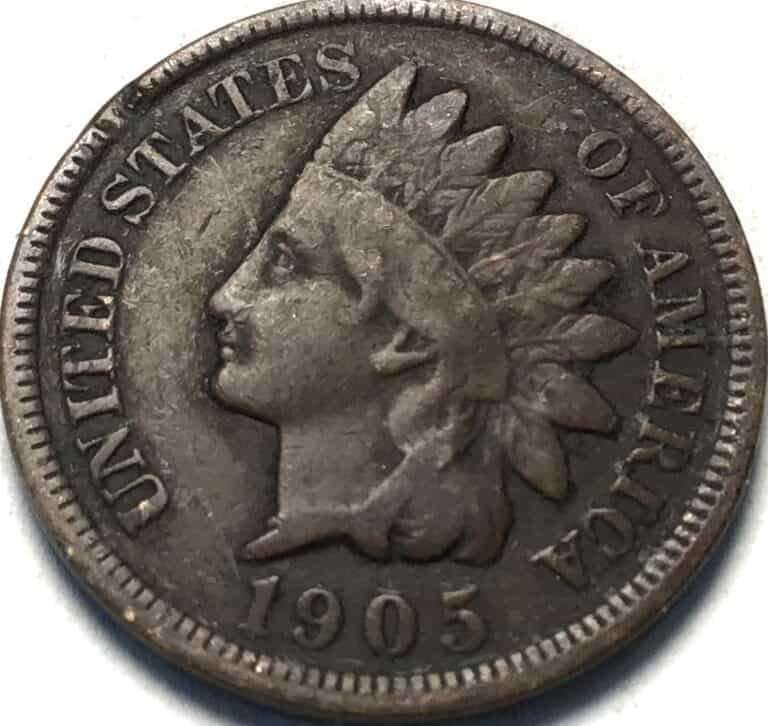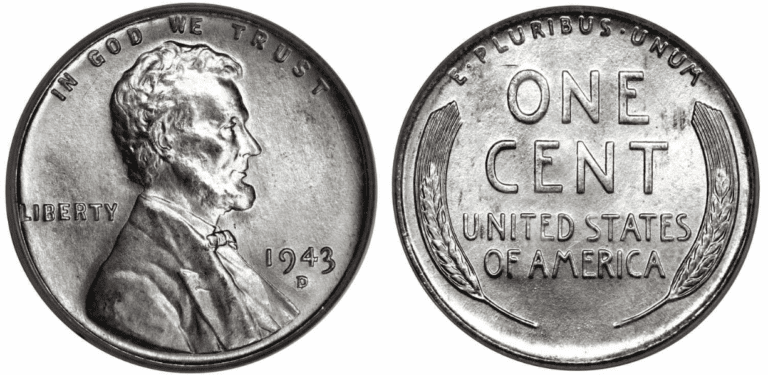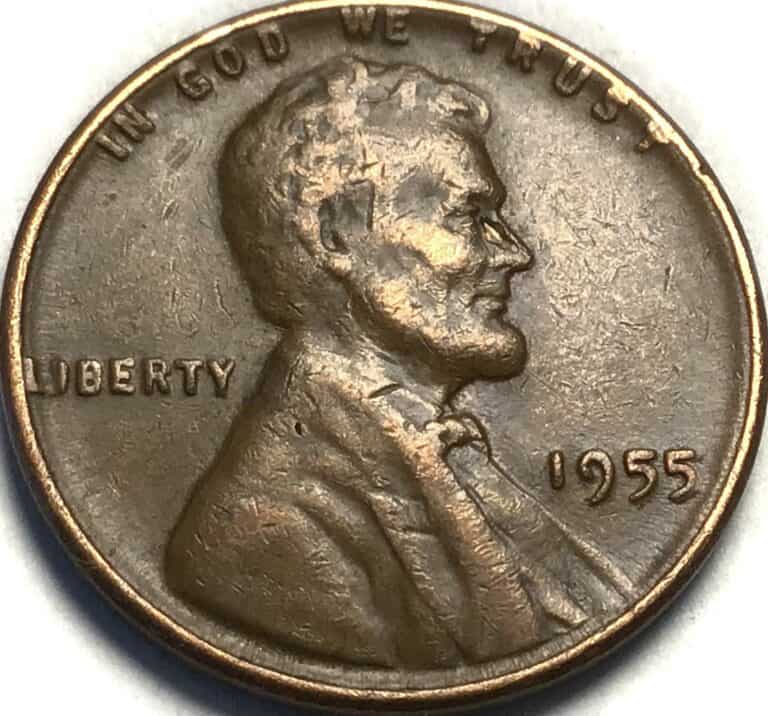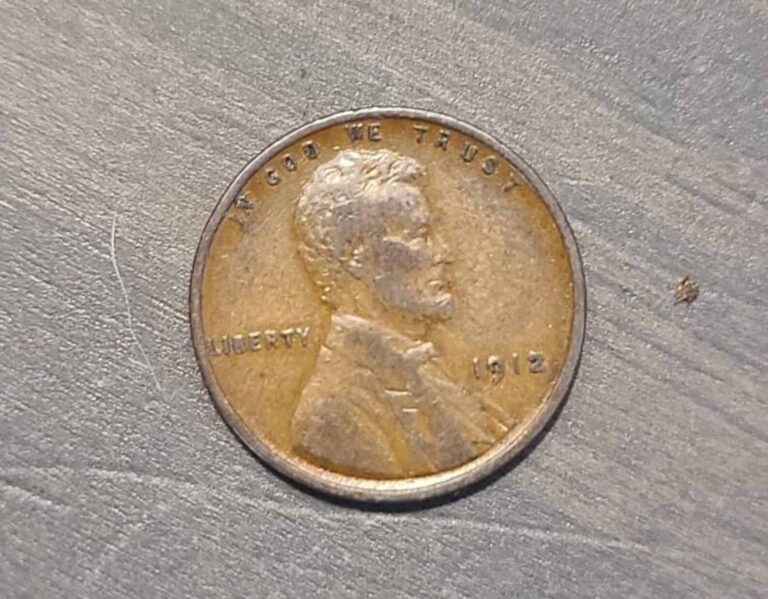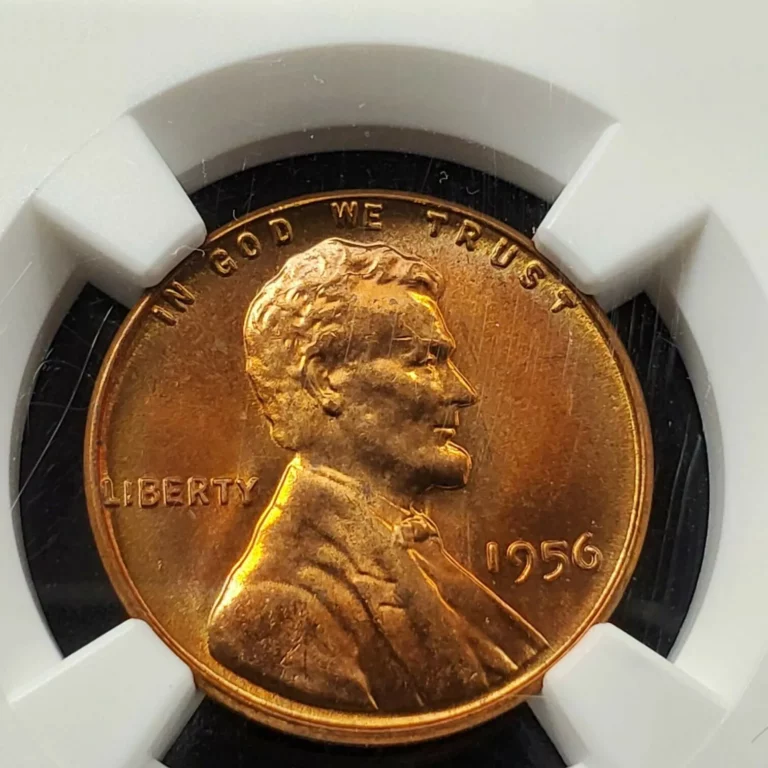1940 Wheat Penny Value: How Much is it Worth Today?

Any coin lover knows that in times of war, the U.S. Mint produced way more coins to support the nation. One such coin that was struck in huge numbers near the United States’ official entry into World War II is the humble penny.
In 1940, over 780 million Lincoln wheat pennies were made in three different Mints. Back then, they cost a measly cent and were a staple in any average American’s coin purse or pocket.
But what is the 1940 wheat penny value today? Did it appreciate or is it the same as in the 1940s? Today, we’ll look at the current prices of the 1940 wheat pennies, as well as what makes a penny rare or coveted in the first place.
1940 Wheat Penny Value Chart |
|||||
| Mint Mark | Extremely Fine | AU58 About Uncirculated | MS62 Uncirculated | MS65 Gem Uncirculated | MS67 Superb Gem Uncirculated |
| 1940 No Mint Mark Wheat Penny Value | $0.35 | $0.85 | $2 | $4.50 to $12 | $37.50 to $170 |
| 1940 “D” Wheat Penny Value | $0.75 | $1.25 | $2.50 | $9.50 to $13 | $33 to $155 |
| 1940 “S” Wheat Penny Value | $0.65 | $1.50 | $2.75 | $10.50 to $18 | $32.50 to $220 |
1940 No Mint Mark Wheat Penny Value

The idea for the Lincoln wheat penny first came to fruition in 1909, the year of the 100th anniversary of Abraham Lincoln’s birth.
The year before, President Theodore Roosevelt—who had been wanting to revitalize American coinage for a while already—met with Victor D. Brenner.
Brenner was a Lithuanian medalist who had a fondness for Abraham Lincoln. Having already designed medals and plaques of Lincoln, he suggested to the president the idea of a coin with Lincoln’s face on it.
The design of the Lincoln penny was simple. On the obverse, we see Lincoln looking to the right. For the first time ever on the U.S. cent, the motto “In God We Trust” was written in an arc on the upper rim of the coin. To the left of Lincoln is the word “Liberty,” and to his right is the date 1940.
The reverse was just as clean and straightforward. In big letters, “ONE CENT” is written in the center, with “United States of America” written in a smaller font under it. These words are cradled by two wheat stalks, hence the name “wheat penny.” The creed “E pluribus unum” is written on top.
Right from its conception in 1909, mintages for the Lincoln wheat penny were already high. Three Mints were assigned to produce them. The Philadelphia Mint made most of the coins, and Denver and San Francisco augmented production to rally the numbers further.
In 1940, the U.S. Mints had outdone themselves with the wheat penny mintage. They had created almost 800 million coins—the highest number the series had seen so far. It was also the biggest-produced coin in all of U.S. coinage that year.
The Philadelphia Mint produced over 568 million wheat pennies in 1940. Many of them were well-made and had a sharp, bold strike, so mint-state coins are quite common even today.
In circulated conditions, a 1940 (P) wheat penny might be valued anywhere between $0.05 (for one in poor or average condition) to $0.85 in grade AU58—the highest circulated grade possible. It may not sound like a lot, but this is a far cry from the coin’s one-cent face value.
Uncirculated, mint-state 1940 (P) wheat pennies are much more valuable though. But it’s important to note that a penny’s coin grade is not the only thing that matters when it comes to pricing it.
Aside from a Lincoln penny’s condition, another factor that comes into play when placing value on this coin is its color. Copper has a vibrant, red luster, but over time, this can fade, giving copper coins a brownish color. So, Lincoln pennies are often categorized into three color designations:
- BN (Brown): Has less than 5% of the coin’s original copper-red luster
- RB (Red-Brown): Has between 5% and 95% of red luster
- RD (Red): Over 95% of its original red luster has been preserved
MS Brown wheat pennies usually mean that they’re circulated. Meanwhile, fully red gems are quite rare and are often found only in mint-state pieces, making them more valuable than their brown and red-brown counterparts.
Let’s take an MS65 1940 (P) wheat penny, for example. In MS Brown, this coin might be sold today at just $4.50. Its MS Red-Brown equivalent will sell for a little higher at $11.50. And in a fully red hue, an MS Red coin can be valued at $12.
The most valuable 1940 (P) wheat pennies will be those in superb gem uncirculated grades (MS67 and MS68) and have a lustrous, red color. An MS67 RD 1940 (P) wheat penny is worth around $170 today, and in a slightly higher grade of MS67+, you can expect to sell it for $900.
And at an unspoiled, untouched grade of MS68, your 1940 (P) wheat penny might be worth around $14,000!
1940 D Wheat Penny Value
Meanwhile, the Denver Mint produced a little over 81 million wheat pennies in 1940—the fewest mintage that year. These pennies have a tiny “D” mint mark just underneath the date on the obverse, so it’s easy to tell if your coin was minted in Denver.
That year, the demand for the pennies was so high that the Denver Mint had to run on a 24-hour schedule to stay on top of their shipments. This was a sign of good business conditions in the country at the time.
Although Denver made the fewest coins out of any Mint in 1940, 81 million is still a huge number, so 1940 D wheat pennies aren’t exactly rare. And because they’re so common, they come to a modest value.
In good, circulated condition, the 1940 D wheat pennies are valued at $0.05. In a slightly less worn, extremely fine condition, the price racks up to a slightly higher $0.75. And at grade AU58, the value sits at $1.25.
Of course, the value gets much higher when the coin is in mint state. An MS65 1940 D wheat pennies, for example, can be worth anywhere between $9.50 and $13. The former value is the current price for an MS Brown coin, while the latter value is that of an MS Red one.
In MS67, the prices for the 1940 D wheat pennies become a lot more sizable. In MS Brown, an MS67 coin can be sold today for around $33. If it has red-brown hues, it might sell for $75. And with a fully red color and luster, the coin might be worth around $155.
1940 S Wheat Penny Value
The San Francisco Mint struck almost 113 million Lincoln pennies in 1940. It is said that people waited in long lines just to get their hands on some new pennies, and so the San Francisco Mint had to work double-time to produce and distribute them, hence the high mintage.
Among the three types of 1940 wheat pennies, it’s the coins made in San Francisco that are most valuable across all grades. This may be because a lot of the coins were made with worn dies, and so sharply struck pieces are a bit rare and hard to come by, increasing their value.
Even in circulated condition, the 1940 S wheat pennies are already higher in value than their cousins minted in Philly and Denver. At AU58, a 1940 S wheat penny is valued at $1.50.
The prices are even higher when the coin is in uncirculated condition. In grade MS65, an MS Brown coin can be sold for $10.50. Its coveted MS Red equivalent, on the other hand, can be sold in modern times for around $18.
But the best, most valuable San Francisco-minted 1940 pennies are those graded MS67 and above and have an MS Red color designation. These coins can be sold at $220 today, and $900 when the grade goes up to a near-perfect MS67+.
1940 Wheat Penny Grading
As with all coins, uncirculated 1940 wheat pennies are immensely more valuable than worn, circulated coins.
You’ll know your coin is circulated if it’s brown or has flat and heavily worn areas on the high points of the coin. On the other hand, it’s easy to spot an uncirculated coin because it usually has fine textures in the design and beautiful eye appeal, shine, and luster all around the coin.
Curious to know what exact coin grade your 1940 wheat penny might be designated? Assess your coin yourself with the help of this guide:
Rare 1940 Wheat Penny Error List
Here are some errors abundant in the 1940 wheat pennies that might pique your interest:
1940 Wheat Penny Doubled Die Obverse Error
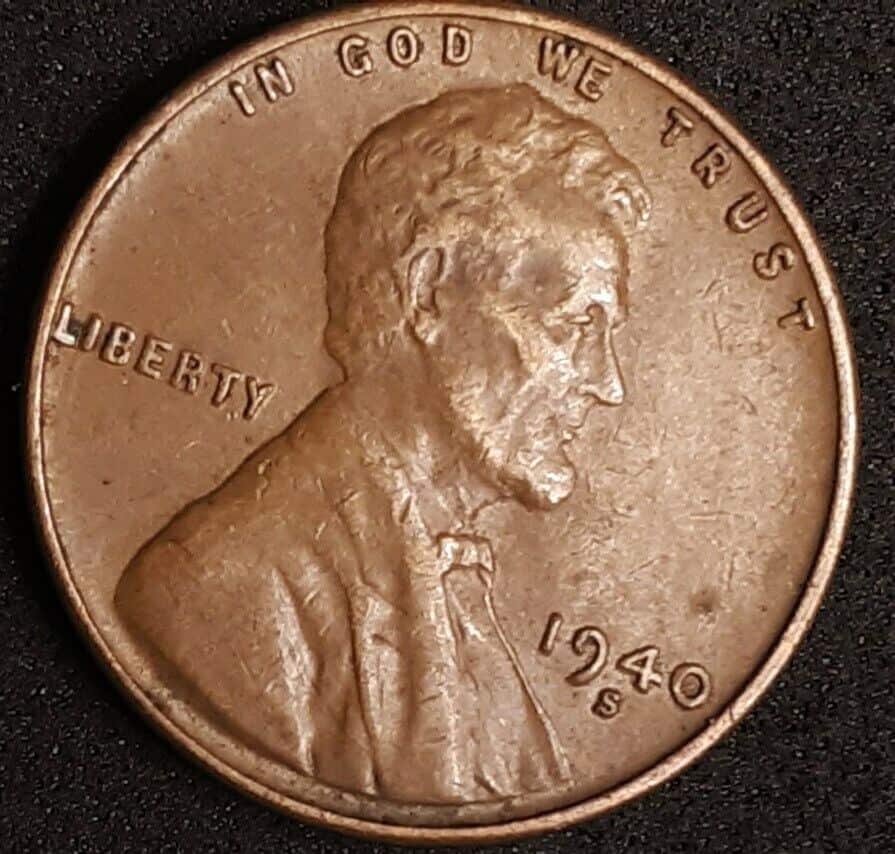
A doubled die coin is a result of a damaged die in the Mint. Dies that aren’t well-made will often find doubling in their design, so when the die is stamped on a planchet, you can see a double image of some of the letters or design elements on the coin.
Use your coin microscope to see if your 1940 wheat penny has this error. It’s most often found on some of the letters of the obverse, specifically where “In God We Trust” is written.
1940 Wheat Penny Repunched Mint Mark Error
The 1940 wheat pennies are also abundant in repunched mint mark errors. This error occurs when the mint mark (either “D” or “S”) is punched twice on the coin, one on top of the other. It’s likely to correct the alignment of a poor first strike.
To give you a gauge as to how valuable this error can make your coin, an MS64 Red 1940 S wheat penny with a repunched mint mark had once sold for around $70. Without this error, a coin with those specs would be valued at around $10 only today.
1940 Wheat Penny Struck Off-Center Error
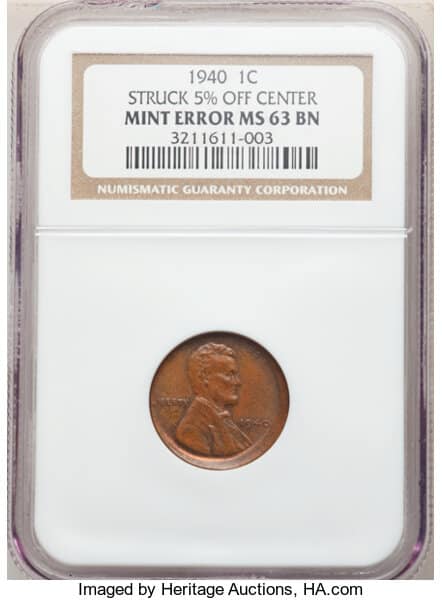
Another error that has been found in some of the 1940 wheat pennies is an off-center strike. This happens when the planchet is not perfectly positioned in the collar. So, when the die stamps itself on the planchet, it doesn’t strike it in the exact middle of the coin.
As a result, the design is stamped in a slightly skewed positioning, leaving some of the planchet blank. Part of the design is also typically missing in coins with off-center strikes.
One 1940 wheat penny that has been found with this error is an MS63 Brown 1940 (P) penny that was 5% off-center. It was sold in 2021 for $83, even if the value of a mint-free penny in this condition is a mere $2.50.
The higher the percentage of the off-center strike, the more valuable the coin. Another 1940 wheat penny was found to be struck 40% off-center. You can clearly see that a big chunk of the planchet was blank in its upper-right-hand corner. It was MS64 Brown and ended up selling for over $200.
1940 Wheat Penny FAQs
Is 1940 wheat pennies worth anything?
Yes, 1940 wheat pennies have appreciated in value over the years, albeit slowly. And although these pennies usually cost a modest price today, some varieties are highly valuable. An example would be coins that have retained their full, red luster and have a high, mint-state grade.
Are 1940 wheat pennies rare?
No. Almost 800 million wheat pennies were struck in 1940, so even in their mintage year, these coins were far from rare. Today, these coins are common across all grades, regardless of which U.S. Mint they were produced in.
What are the rarest wheat pennies?
The rarest wheat penny known to exist is the 1909 VDB wheat penny. This penny was minted with the initials of Victor D. Brenner, the designer of the coin. Later that year, the initials were scrapped completely, making the “VDB” penny variety rare. Today, they can be sold for thousands of dollars.
What years of wheat pennies are valuable?
Wheat pennies struck in small numbers are usually the most valuable today. Many of these issues were minted in San Francisco, which is a Mint known to produce way fewer coins than other Mints.
Specifically, “S” wheat pennies struck between the years 1910 and 1915 are incredibly scarce, and therefore, immensely valuable.

